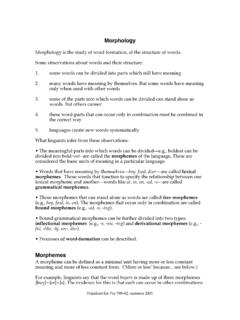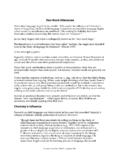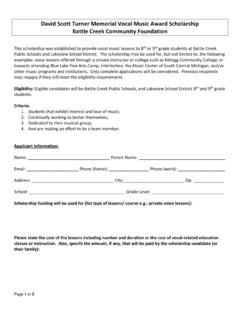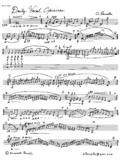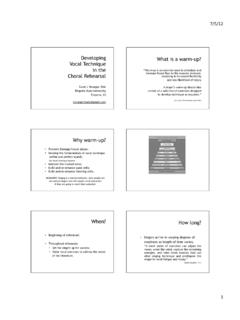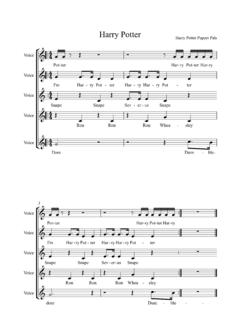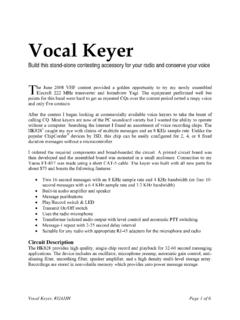Transcription of Phonology - Duquesne University
1 Handout for Psy 598-02, summer 2001 PhonologyPhonology is the study of the sound system of language. It is the study of the widevariety of sounds in all languages, of the basic units of sound in a particular language,and of the regularities and rules that govern pronunciation of observations about the sounds of language:1. the sounds of words are made by blowing air through the throat, mouth, and/ornose2. speech is a continuous stream, but we hear separate speech sounds3. the same sound recurs in different words (though often spelled differently)4. the sounds of speech can be analyzed into smaller units5. the sounds of speech will vary from one context to anotherWhat linguists infer from these observations: Phonologists pay attention to the structure of the vocal tract, and the articulation ofsounds by the vocal apparatus.
2 They try to identity the basic sounds of a language its phonemes. Phonemes can be further analyzed into their distinctive features. Systematic changes in the phonemes (allophones) when they are combined intolonger sounds are described in terms of phonological of The vocal TractThe production of speech involves the skillful manipulation of all the components of thevocal tract:lips (1 in diagram below)teethtonguealveolar ridge (4): the bony ridge behind the upper teethhard palate (7): the bony dome constituting the roof of the mouthPackerPhonology 2velum, or soft palate (8): the soft tissue immediately behind the tongue; when raised, itforces all air through the mouth; lowered, it allows air through the noseuvula (9): the soft appendage hanging from the velumpharynx (10): the back wall of the throat behind the tonguelarynx (11): containing the vocal cordstrachea: the tube going to the lungsPhonemes: Segments of SoundHow to represent the sounds of speech?
3 Written forms often provide little guide toactual pronunciation, in English at approach has been to develop a specialized notation to represent the sounds of anylanguage. The International Phonetic Alphabet is the best known of these.[b] as in bird, [d] as in dog; [ ] as in XX; [ ] as in ..; [ ] as in ..The IPA is a system of phonetic transcription. It is generally considered to provide auniversal, language-independent, description. A phonetic or phonologicaltranscription encloses elements in brackets: [ ].PackerPhonology 3 The IPA can be used to describe the wide variety of sounds used in all the world slanguages. However, each language uses a relatively small number of sounds. Thesebasic sounds are called the phonemes of the average a language has around 35 phonemes. British English has 44, on phonemic transcription encloses elements in slashes: //Theoretically, the symbols used in a phonemic transcription have no specialsignificance: one could use /1/, /2/ instead of /p/ and /b/.
4 In practice, of course, thiswould make a transcription almost impossible to phoneme is the smallest segment of sound which can distinguish two words. Thewords pit and bit differ only in their initial sound: /p/ in one case, /b/ in the that differ by only one sound are known as minimal pairs, and one way to lookfor the sounds of a language is to search for such English accent known as Received Pronunciation has 24 consonant phonemes and20 vowel phonemes, of which 12 are pure vowels (as in bit, bet, bat, but) and 8 arediphthongs or gliding vowels (as in boat, buy, bay).How Real are Phonemes?Linguists generally have agreed that when we hear speech we perceive these phonemesas sound segments. The phoneme has seemed to be, both intuitively and analytically,the ultimate unit of speech. However, some linguists have recently declared the deathof the phoneme : they claim that the phoneme is an illusion (Kaye, 1989, p.)
5 149).PackerPhonology 4An indication of the problematic status of the phoneme can be seen in Linguistics forNon-linguists: on two facing pages phonemes are described as percepts psychologicalunits, as abstract entities postulated to account for the fact that speakers of as different, and finally that when we talk, we utter a physicalspeech signal which we interpret as containing phonemes (p. 106-107, originalemphasis). (And on page 110 we re told are theoretical constructs within atheory of Phonology .) Percepts, interpretations, or abstract theoretical constructs?But because the news that the phoneme is dead is not widely shared, we ll proceed herein terms of the standard phonological Properties of PhonemesThe phonemes of a language are not totally separate entities; they share commonfeatures.
6 Any feature that distinguishes some phonemes from others is called adistinctive example:/b/, /d/, /m/, /n/ are all voiced: they are pronounced with vibration of the , /b/, and /m/ are all pronounced with the /m/ and /n/ are spoken, air is expelled through the are several different ways of analyzing phonemes into their distinctive standard way is to describe vowels in terms of the features of [high], [low], [back],[round] and [tense]:[high] = height of tongue in the mouth (/i/ is high, /e/ is mid, /a/ is low).[front] = position of tongue: towards the lips (/i/), or towards the velum (/u/).[round] = degree of rounding of the lips (/u/ is round, /e/ is spread).[tense] = state of vocal muscles (/u/ is tense, /a/ is lax).For a very good animated demonstration of the anatomy of vowel production, point your browserto: and click to hear each vowel sound and see tongue position (n.)
7 B. this animationrequires that your browser has the Shockwave plug-in).PackerPhonology 5 PackerPhonology 6 Consonants can be similarly described, in terms of the features of [place], [manner],and [voice]:[place] = the location of the constriction in the vocal tract:bilabial (/p, b, m, w/), labiodental (/f, v/), interdental (/q/), alveolar (/t, d, s/),palatal (/r, y/), velar (/k, g/), and glottal (/h/).PackerPhonology 7[manner] = the manner of the constriction:stops (/p, b/): the flow of air is completely blockedfricatives (/f, v, q/): air flow is impeded but not completely blockedaffricatives (/XX/): begin like a stop and end like a fricativePackerPhonology 8nasals (/m, n/): air flows through the nose, is blocked through the mouthliquids (/l, r/): between true consonants and vowels: l-like and r-like soundsand glides (/w, y/): between true consonants and vowels: vocal tract isconstructed, but not enough to block or impede the airflowStops, fricatives and affricatives are sometimes called obstructives, while nasals,glides and liquids are called sonorants.
8 [voice] = whether or not the vocal cords are vibrating:voiced (/b, d, g, m, ), unvoiced (/p, t, k, ).For a demonstration of the articulation of consonants, go to: that stops, fricatives and affricatives always come in voiced and voiceless pairs(except for /h/). Nasals, liquids and glides are all voiced. All vowels are phoneme, then, can be described in terms of these distinctive features. Forexample:/p/ = [+bilabial, +stop, -voice]/r/ = [+palatal, +liquid, +voice]PackerPhonology 9It will be evident that phonological analysis is based (somewhat indirectly) on thephysiology of the vocal tract. The distinctive features of a phoneme correspond to theform of articulation of the vocal tract when that phoneme is , one complication is the fact that the phonemic representation of the words ina language is not identical for every speaker.
9 English has a variety of dialects, each ofwhich is spoken in ways that differ somewhat from person to person: these individualdifferences are called complication is that every language has non-segmental aspects to the way PhonemesA language like Chinese has words that are distinguished by differences in the rise andfall of (level tone) = motherma (rising tone) = hempma (dipping tone) = horsema (falling tone) = scoldMetrical PhonologyEnglish doesn t have tones, but it does have important non-segmental features. Inparticular, each word and phrase has a rhythm, a pattern of stressed and unstressedsyllables. Phonologists have recently begun to study these seems to be an internal structure to rhythm, or alternating strong (S) and weak(W) portions. For example:r e f o r m a t i o n S W S W W SAnd stress plays a part in the indication of meaning, as we shall see Phonemes: Phonological ProcessesWe ve seen thatin most analyses phonemes are the units of language on the level of itssounds.
10 Linguists also look for rules that specific the organization of these units, toexplain phenomena like the following:the is pronounced th[ ] when the following word begins with a consonant, and th[i]when it begins with a vowel. Compare the duck and the phoneme /t/ is pronounced differently in different contexts: Tim, stem, hit, hit me,Betty. In Tim the /t/ is aspirated; in stem it is released but not aspirated; in hit it can bePackerPhonology 10released or unreleased; in hit me it may be unreleased or may be a glottal stop; in Betty itis an alveolar flap (in English, though not in British English, which is why a BritishMartin is hard for Americans to recognize).These are allophones, and they are predictable. A careful description of phenomenasuch as these will link the phonemic level and the phonetic level of rules address additional phenomena, such as:aspiration: /p/ becomes /ph/ when it both begins a syllable and is followed by astressed vowel.
